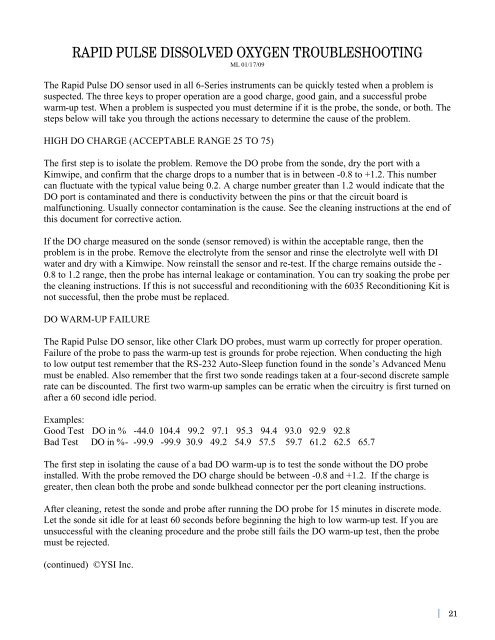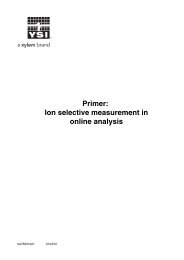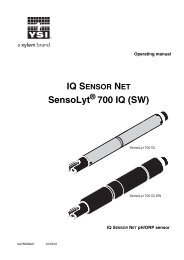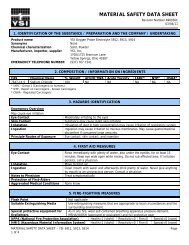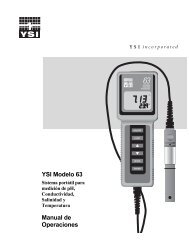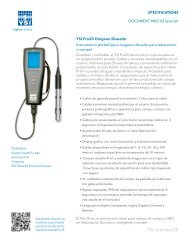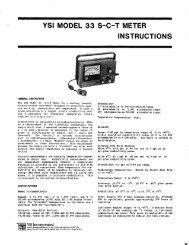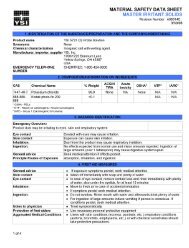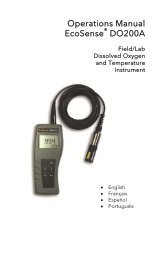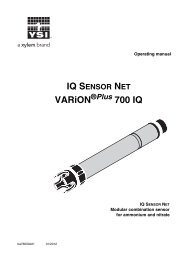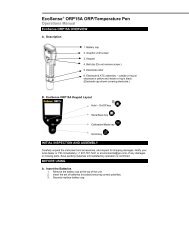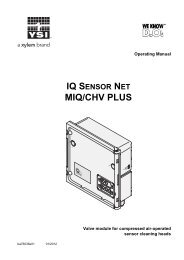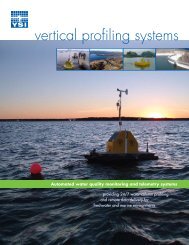YSI Calibration Tips Dissolved Oxygen Excerpt - YSI.com
YSI Calibration Tips Dissolved Oxygen Excerpt - YSI.com
YSI Calibration Tips Dissolved Oxygen Excerpt - YSI.com
Create successful ePaper yourself
Turn your PDF publications into a flip-book with our unique Google optimized e-Paper software.
RAPID PULSE DISSOLVED OXYGEN TROUBLESHOOTINGML 01/17/09The Rapid Pulse DO sensor used in all 6-Series instruments can be quickly tested when a problem issuspected. The three keys to proper operation are a good charge, good gain, and a successful probewarm-up test. When a problem is suspected you must determine if it is the probe, the sonde, or both. Thesteps below will take you through the actions necessary to determine the cause of the problem.HIGH DO CHARGE (ACCEPTABLE RANGE 25 TO 75)The first step is to isolate the problem. Remove the DO probe from the sonde, dry the port with aKimwipe, and confirm that the charge drops to a number that is in between -0.8 to +1.2. This numbercan fluctuate with the typical value being 0.2. A charge number greater than 1.2 would indicate that theDO port is contaminated and there is conductivity between the pins or that the circuit board ismalfunctioning. Usually connector contamination is the cause. See the cleaning instructions at the end ofthis document for corrective action.If the DO charge measured on the sonde (sensor removed) is within the acceptable range, then theproblem is in the probe. Remove the electrolyte from the sensor and rinse the electrolyte well with DIwater and dry with a Kimwipe. Now reinstall the sensor and re-test. If the charge remains outside the -0.8 to 1.2 range, then the probe has internal leakage or contamination. You can try soaking the probe perthe cleaning instructions. If this is not successful and reconditioning with the 6035 Reconditioning Kit isnot successful, then the probe must be replaced.DO WARM-UP FAILUREThe Rapid Pulse DO sensor, like other Clark DO probes, must warm up correctly for proper operation.Failure of the probe to pass the warm-up test is grounds for probe rejection. When conducting the highto low output test remember that the RS-232 Auto-Sleep function found in the sonde’s Advanced Menumust be enabled. Also remember that the first two sonde readings taken at a four-second discrete samplerate can be discounted. The first two warm-up samples can be erratic when the circuitry is first turned onafter a 60 second idle period.Examples:Good Test DO in % -44.0 104.4 99.2 97.1 95.3 94.4 93.0 92.9 92.8Bad Test DO in %- -99.9 -99.9 30.9 49.2 54.9 57.5 59.7 61.2 62.5 65.7The first step in isolating the cause of a bad DO warm-up is to test the sonde without the DO probeinstalled. With the probe removed the DO charge should be between -0.8 and +1.2. If the charge isgreater, then clean both the probe and sonde bulkhead connector per the port cleaning instructions.After cleaning, retest the sonde and probe after running the DO probe for 15 minutes in discrete mode.Let the sonde sit idle for at least 60 seconds before beginning the high to low warm-up test. If you areunsuccessful with the cleaning procedure and the probe still fails the DO warm-up test, then the probemust be rejected.(continued) ©<strong>YSI</strong> Inc.21


